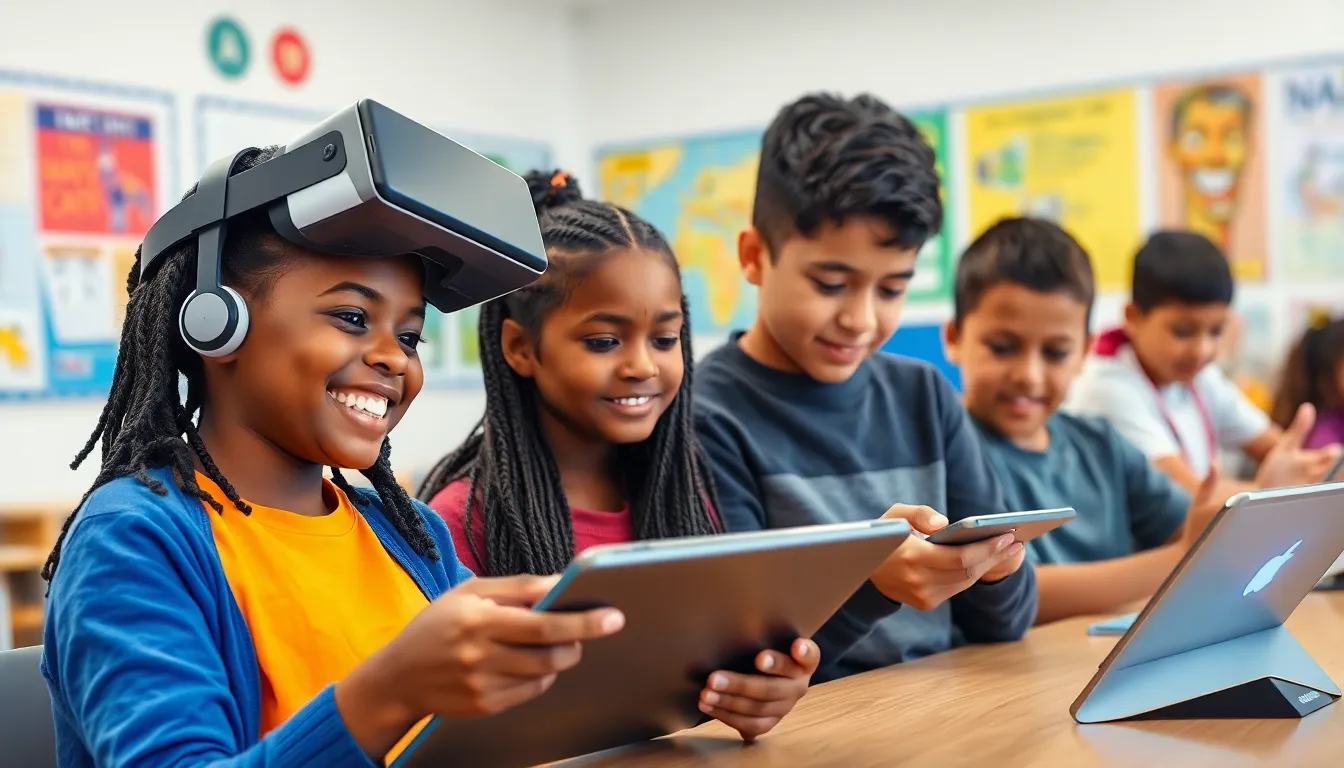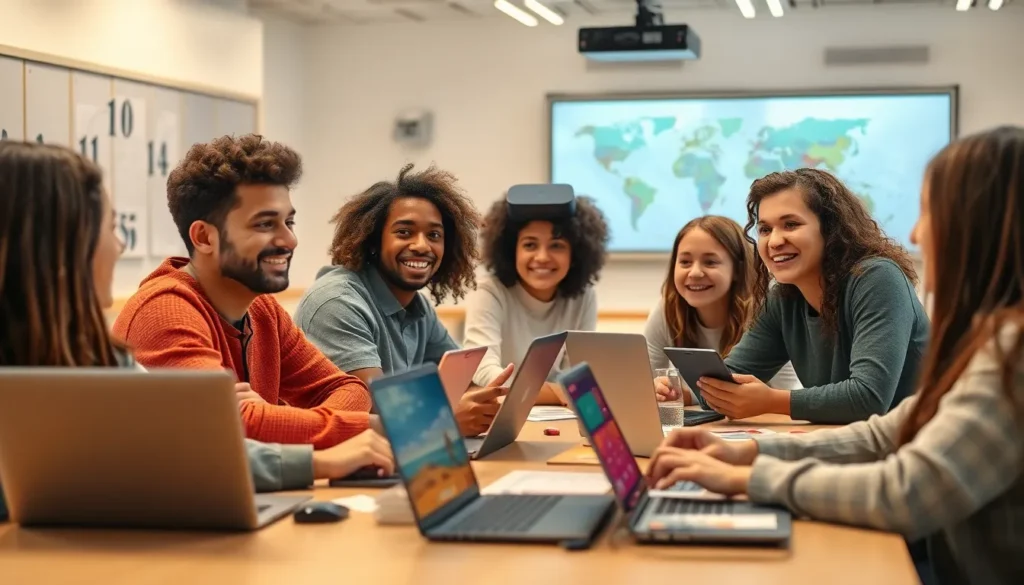Table of Contents
ToggleIn today’s fast-paced world, technology is the new superhero in education, swooping in to save students from the perils of boredom and outdated textbooks. Gone are the days of dusty chalkboards and endless lectures; now, classrooms buzz with interactive apps and virtual reality adventures. Who knew learning could be this much fun?
As educators embrace tech, they’re not just upgrading their tools; they’re transforming the entire learning experience. From personalized learning paths to engaging online discussions, technology is reshaping how knowledge is shared and absorbed. So, buckle up as we dive into the exciting realm of tech in education, where learning meets innovation and students become the heroes of their own educational journeys.
Overview of Tech in Education
Technology transforms education by integrating tools and platforms that enhance learning experiences. Online learning management systems facilitate course delivery, allowing educators to manage content and track student progress efficiently. Virtual classrooms enable real-time interactions, fostering collaboration among peers and teachers.
Interactive apps and educational software support personalized learning paths. These tools adapt to individual student needs, catering to diverse learning styles and paces. Gamification incorporates game mechanics into lessons, making learning both fun and engaging.
Data analytics plays a vital role in assessing student performance. Educators utilize this data to identify strengths and areas for improvement, tailoring instruction accordingly. Digital assessments provide immediate feedback, allowing students to understand their progress and areas needing attention.
Moreover, mobile devices extend learning beyond the classroom. Students access educational resources anytime and anywhere, promoting a culture of continuous learning. This flexibility accommodates various schedules, ensuring all learners can engage with education on their terms.
Another significant advancement is the use of virtual and augmented reality. These technologies immerse students in experiential learning environments, enhancing understanding of complex concepts. For instance, virtual field trips expose students to global cultures and environments without leaving the classroom.
By embracing technology, educational institutions prepare students for the demands of the modern workforce. Skills such as digital literacy and critical thinking become essential, as technology permeates various industries. Adapting teaching methods to incorporate tech ensures that students remain competitive in a rapidly changing world.
Benefits of Tech in Education

Technology enhances the educational landscape by providing innovative tools and methods that foster active engagement. The integration of tech enriches learning experiences, making lessons more interactive and enjoyable.
Enhanced Learning Experience
Interactive apps engage students through immersive activities. Virtual reality transports learners to new environments, enabling them to explore complex subjects. Gamification techniques motivate students by turning lessons into challenges. Real-time feedback facilitates immediate improvement through digital assessments. Enhanced collaboration occurs in virtual classrooms, encouraging participation and discussion. Tools like learning management systems streamline course delivery, tracking student performance seamlessly. Such advancements cultivate a dynamic learning atmosphere, promoting deeper understanding and retention.
Personalized Learning
Personalization adapts learning materials to meet individual student needs. Algorithms analyze performance data, tailoring content to address strengths and weaknesses. This personalized approach fosters motivation, allowing learners to progress at their own pace. Customized learning paths provide students with targeted resources for skill development. Educators gain insights through analytics, refining instructional strategies based on real-time data. Engagement increases as students participate in lessons designed specifically for them. Diverse learning styles receive attention, ensuring that every student feels supported in their educational journey.
Challenges of Tech in Education
Technology enhances education, yet it also presents several challenges that institutions must address.
Digital Divide
Access to technology remains unequal among students. Many learners lack reliable internet or access to devices, hindering their ability to participate fully in digital learning environments. In low-income areas, this divide widens, creating disparities in educational outcomes. Students without access often fall behind their peers who benefit from technology-driven resources. Schools must implement strategies to bridge this gap, ensuring all students can engage with educational technology. Collaborative efforts between governments, private sectors, and educational institutions can help provide necessary resources, promoting inclusivity. Effective programs that offer devices and internet access significantly contribute to reducing the digital divide.
Data Privacy Concerns
Data privacy poses serious implications in educational contexts. With increased use of online platforms, student data becomes vulnerable to breaches. Many educational technologies collect personal information, raising concerns about how this data is secured and utilized. Parents and educators worry about unauthorized access to sensitive information. Institutions must adhere to regulations like the Family Educational Rights and Privacy Act, ensuring student data remains confidential and protected. Transparent policies regarding data collection and usage can foster trust among parents and educators. Furthermore, frequent training on data privacy for educators reinforces the importance of safeguarding student information.
Future Trends in Tech in Education
Technology continues to reshape education with innovative trends that enhance learning experiences. Two key areas poised for growth are artificial intelligence and virtual reality.
Artificial Intelligence in Classrooms
Artificial intelligence consistently provides personalized learning experiences tailored to each student. AI systems can analyze student performance in real-time, allowing educators to adapt lesson plans and interventions based on unique needs. Chatbots often assist with immediate questions, fostering engagement outside classroom hours. Adaptive learning platforms utilize algorithms to deliver customized content, ensuring students progress at their own pace. With ongoing advancements, AI is expected to deepen its role in automating administrative tasks, giving educators more time to focus on instruction.
Virtual and Augmented Reality
Virtual and augmented reality offer immersive learning environments that revolutionize how students understand complex subjects. These technologies transport students to historical sites, scientific labs, or even outer space, enriching their educational experience. Lesson engagement increases significantly when learners interact with 3D simulations, enhancing retention and understanding. Moreover, educators can incorporate VR and AR into various curricula, providing visual context for abstract concepts. By integrating these immersive technologies, educational institutions prepare students for a tech-driven world while making learning more enjoyable and effective.
The integration of technology in education is reshaping how students learn and engage with content. As tools evolve from traditional methods to innovative platforms like AI and VR, the learning landscape becomes more dynamic and personalized.
While challenges such as the digital divide and data privacy concerns remain, the potential benefits far outweigh the obstacles. By embracing these advancements, educational institutions can equip students with essential skills for the future.
Ultimately, the journey of technology in education is just beginning, promising exciting possibilities for enhanced learning experiences and greater equity in education.




